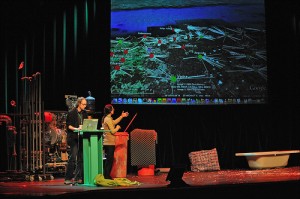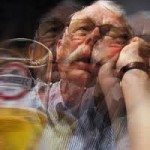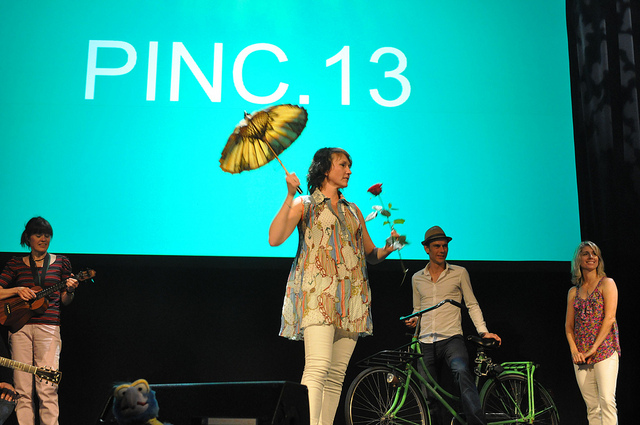What a great conference!!! PINC (People, Ideas, Nature, Creativity) is like a Dutchified version of TED, and the main theme seems to be creativity — that’s what the “C” stands for — and what creativity looks like across disciplines including: science and its societal relevance, art and design, food, philosophy, and a few others. It was beautifully executed, as would be expected given the price tag of €900/seat for non-speakers — the timing and lights, stage design, headphones with spontaneous translation of the Dutch talks (about half), sound quality, music…yes music!…and dance! The day opened with a pair of tap-dancers who were just excellent, and it ended with a 13-year old boy playing Brahms and something else on piano, at a level that easily matched adult solo concert performers. He was shockingly good. And in between, all these 20-minute talks…
The talks were so good that I felt quite insecure about mine. So I snuck out during coffee breaks and lunch to revise and upgrade my slides. Then, at the end of each break, they played a recording of an oom-pah-pah band..which actually got louder by the minute, in order to herd people back in. Pretty progressive, don’t you think? Rather than flashing the lights and hollering. Boisterous happy music at swelling volume to get people to stop chatting and sit down. That’s the sort of creativity that characterized the whole thing.
 How do I give a sense of the diversity of the talks? Well, one was by an American living in Antartica to study penguins and another was by a Swiss biologist who had camped out with bears for 3 months in Alaska. Then there was the harder science stuff — but mixed with liveliness and humor and surprises. For example, a pair of guys who came on like comedians — Mikael from Finland and Roman from Switzerland — Laurel and
How do I give a sense of the diversity of the talks? Well, one was by an American living in Antartica to study penguins and another was by a Swiss biologist who had camped out with bears for 3 months in Alaska. Then there was the harder science stuff — but mixed with liveliness and humor and surprises. For example, a pair of guys who came on like comedians — Mikael from Finland and Roman from Switzerland — Laurel and  Hardy? They stood on either side of a tippy blackboard, took turns with the chalk, and showed how the curve describing the success and failure of political figures (high rise, low dip, then slow rise and plateau, or not) was mathematically identical to that describing the rise and fall (and hopefully rise again) of marriages. (By the way, that corresponds perfectly to a neurochemical model, by which the first year of a romantic relationship is all about the rise and then fall of dopamine, as the “reward” gets more “predictable” — to be followed by an attachment relationship based on endogenous opioids. Must publish that some day, though it’s probably been done.) Then, my favourite, a condensed history of the Corduroy Appreciation Club in NYC. The speaker was dry and pedantic (a spoof, as it turned out) and revealed many interesting factoids, including the significance of meeting dates. The annual meeting is always held on November 11, as the date so nicely symbolizes the very essence of corduroy (11.11). Of course the big one was held in 2011. The secret handshake, that involves interlacing but parallel fingers. There was even video footage of one member being dragged out by (hooded) security guards for a major infringement of the
Hardy? They stood on either side of a tippy blackboard, took turns with the chalk, and showed how the curve describing the success and failure of political figures (high rise, low dip, then slow rise and plateau, or not) was mathematically identical to that describing the rise and fall (and hopefully rise again) of marriages. (By the way, that corresponds perfectly to a neurochemical model, by which the first year of a romantic relationship is all about the rise and then fall of dopamine, as the “reward” gets more “predictable” — to be followed by an attachment relationship based on endogenous opioids. Must publish that some day, though it’s probably been done.) Then, my favourite, a condensed history of the Corduroy Appreciation Club in NYC. The speaker was dry and pedantic (a spoof, as it turned out) and revealed many interesting factoids, including the significance of meeting dates. The annual meeting is always held on November 11, as the date so nicely symbolizes the very essence of corduroy (11.11). Of course the big one was held in 2011. The secret handshake, that involves interlacing but parallel fingers. There was even video footage of one member being dragged out by (hooded) security guards for a major infringement of the  society’s policies: he was only wearing two pieces of corduroy — not three, as required for the annual meeting. The silly bugger: I mean, adding a corduroy tie would have been sufficient. Other talks included one session on baking bread in Africa and one on how to fold paper so as to create amazingly detailed works of art, such as the Escher-like staircase you see here. The angle of the light turns out to be all important.
society’s policies: he was only wearing two pieces of corduroy — not three, as required for the annual meeting. The silly bugger: I mean, adding a corduroy tie would have been sufficient. Other talks included one session on baking bread in Africa and one on how to fold paper so as to create amazingly detailed works of art, such as the Escher-like staircase you see here. The angle of the light turns out to be all important.
 Then there was me, talking about addiction, self-destruction, ego fatigue, and the absence of self-trust. I felt like a bit of a downer, but I tried (and got away with) a few jokes. Examples? One about my ambivalence about the publicity I’ve gotten here in Holland — like bringing the boys to school and having the other parents smile and nod at me: Oh, you’re the drug addict! Saw you on TV last night. Chuckle. People seemed to appreciate the talk. Lots of nice compliments afterward. The Dutch really like honesty — one reason why I really like the Dutch. I’ll see if I can figure out how to post the talk. But maybe TED will be more polished. I can only hope.
Then there was me, talking about addiction, self-destruction, ego fatigue, and the absence of self-trust. I felt like a bit of a downer, but I tried (and got away with) a few jokes. Examples? One about my ambivalence about the publicity I’ve gotten here in Holland — like bringing the boys to school and having the other parents smile and nod at me: Oh, you’re the drug addict! Saw you on TV last night. Chuckle. People seemed to appreciate the talk. Lots of nice compliments afterward. The Dutch really like honesty — one reason why I really like the Dutch. I’ll see if I can figure out how to post the talk. But maybe TED will be more polished. I can only hope.

Leave a Reply